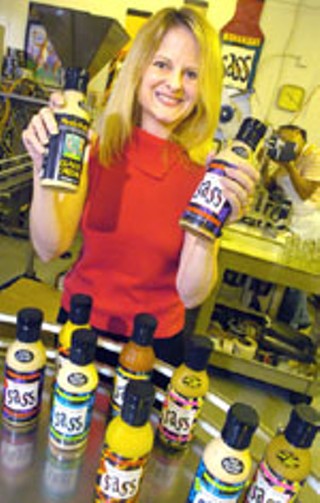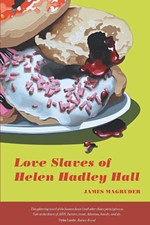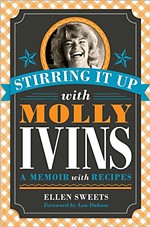The Sauce Boss
Lauri Raymond looks back on and forward to the life and times of SASS dressing
By Barbara Chisholm, Fri., June 11, 2004

On Sept. 17, 1987, Lauri Raymond gave birth. Twice. Her son, Ben Raymond-Henshaw, was born at home at 1:22pm. The exact time of the birth of Sisters & Brothers Inc. is less clear, but the Season All Stuff Sauce company was born as Lauri labored in a birthing tank in her living room. In attendance at the birth of both son and company was Lauri's identical twin sister and best friend, Carol. Although their lives have included periods living in different cities and pursuing paths that weren't always parallel, the sisters have always been as close as the physical resemblance suggests. And coincidentally, Sept. 17 is also their birth date. This is the story of the birth, infancy, and adolescence of a local company that is on the brink of adulthood.
Expecting
In September of 1987, Carol Raymond's son Noah was 4 years old, and she was employed as part of the small staff of Recording for the Blind. Lauri, an acclaimed actress, was a member of the Project InterAct company at Zachary Scott Theatre, which tours plays for young people around the state. Lauri realized she wouldn't be able to continue touring during and after her pregnancy. Carol was not unhappy in her job but found it predictable. The sisters had often toyed with the idea of going into business together. "We thought we would make good business partners – we think alike," Lauri remembers. "And we thought it would be fun. We felt like we could do it in a way that was conscious. We felt like if we're going to do it, we want to create the kind of business that we would want to work for. It needs to be fun, it needs to be socially responsible, environmentally responsible, and we want to treat people well."
They weren't typical start-up types: Lauri was a business major for one semester of college, but was put off by her classmates' repeated inquiries about the necessity of complying with safety regulations and paying minimum wages. Carol, however, was a marketing major, and she armed herself with a workbook on how to start a business, which served as their blueprint.
They were toying with various ideas for a business when on a holiday trip to Santa Fe, Carol and her then husband, Keith, ate at a vegetarian restaurant that featured a house salad dressing they found irresistible. Carol begged the waitress for the recipe, but it was a closely guarded secret. Upon returning to Austin, Carol began experimenting with making an equivalent of the dressing in her kitchen. For Christmas gifts in 1986, Carol gave her office mates at Recording for the Blind small cruets of her concoction. My then fiancé and current husband, Chronicle Arts Editor Robert Faires, was one of those office mates, and he brought the dressing to me. It was the most garlicky, addictive, delicious, and unique dressing I had ever tasted. I liberally poured the dressing on salad greens, then baked potatoes, then pasta, until I forlornly faced the bottom of the cruet. I returned the cruet to Carol at the office and offered her five bucks if she would refill it with the magical sauce. Bingo! The sisters had found their business.
Taking the dressing from a small kitchen-produced batch for friends to a grocery-store-ready product was an endeavor. For starters, they had to come up with a real recipe that would allow for a consistent product. With the advice of their early third partner and professional cook, Celeste Seay (who was bought out of the partnership in 1988), to guide them, they settled on an exact recipe and a primitive method of production.
"We had this bottle that had masking tape around it at a certain level," Lauri says. "We would pour in the lipids, hold the bottle next to it and pour it up to there, then the water-based stuff to the next level. Then we had to get the garlic in there. We started getting a tablespoon and scooping with a finger into the bottle. Then we found these veterinarian syringes, the really fat ones. We cut the ends off of them so there was just this wide hole there. And we crushed the garlic and sucked it up to a certain point [on the syringe], and then we would inject it into every bottle."
Production technology advanced in unexpected ways. "We found a tank that used to be a snow-cone blending machine in someone's back yard. It stirs up the whole thing. At first we were too afraid of trying it with the garlic. We were so afraid of the garlic sinking down to the bottom, and the first bottles would have all the garlic and the rest wouldn't. You have to imagine: If we did it with the whole batch and it didn't work, then we were going to have to throw away the whole batch. And that just seemed like horror of horrors! We can't just throw away a whole batch; we don't have the money to do that. Finally we got up the guts to dump all the garlic in there. And it held it suspended, we found out. So that was an exciting day for us."
Birth
So, with a rudimentary production method in place, the next step was to get it into stores. Whole Foods and Wheatsville were considered their first markets for ideological and practical reasons. The Sesame-Garlic SASS is all-natural and homegrown, and at that time Whole Foods was a friendly little store at a flood-prone spot on 10th & Lamar. The sisters pitched the product to the produce managers, and the managers agreed to give it a shot. Wheatsville was the very first sale, but the first demo took place at Whole Foods. Wisely, the SASS team knew they had to get the product into the mouths of customers. After all, selling a case to a market doesn't help if the case just sits there on the shelf. Carol, Celeste, Lauri, and Baby Ben in a sling on Lauri's back all attended the initial demo. "That day we sold everything that we had sold to Whole Foods. We went over to Wheatsville and bought back the cases that we had sold to Wheatsville. That was back in the day that you didn't see a demo every corner of every store every day. People were swamping us."
Infancy
This lesson of the demo is still the key to sales today. The tasting of the product gets a customer over the sticker shock that a fresh, refrigerated product produces. "We knew that it being a refrigerated product would be a barrier. The thing about the Sesame-Garlic is that the garlic is fresh. And it has that little bite to it. So it just flattened everything out [when we cooked it]. We thought about pasteurizing it, but we never could make it work. We did vitamin C. It didn't seem to significantly alter the shelf life."
Production of the dressing moved from Carol's kitchen to a small commercial venue they shared with Out to Lunch. A variety of different flavors was always part of the long-term plan. The first new flavor came out in 1990: Tomato-Basil SASS. Bombay-Ginger SASS was next in 1995. Compared to other companies, this introduction of new products was quite slow, but typical for Sisters, they went about it in their own way. "Where we came up with [new flavors] was, 'Oh, I like ginger! We should make a ginger one. I like this. We should make a this. We should do a ranch that tastes like chipotle.'" (This particular inspiration was realized in their Rancho-Grande SASS, introduced in 1998.)
While Sisters hardly followed a typical Harvard five-year plan approach to their business, they did have a plan: to make a quick million bucks and get out. The first sign that their plan might not work was that the millions didn't roll in. "This whole thing has been an exercise in welcoming where I am. And kind of being OK with where I am and what I'm doing and what I've been given." A place Lauri found herself in February of 1994 was alone in Austin with the company: Sister Carol had moved to Santa Fe.
Early Childhood
For a company founded by sisters and named for sisters, it was an adjustment to find herself singularly at the helm of the dressing company. But Lauri has never considered herself abandoned. Carol made all the options available to Lauri: disbanding the company, buying her out, etc. Lauri decided to keep it Sisters, in name and spirit. As she points out, in the early days of the company, Carol did the heavy lifting. Lauri was a brand-new mom who had limited time to devote to the fledgling operation. To this day, all major company decisions are still run past Carol.
With just one person at the head, the office of the business was moved out of a rental space and into Lauri's home for convenience and financial reasons. She also made the big decision to pay herself a living wage for the first time in the company's history.
Adolescence
In July of 1997, Sisters attended their first national trade show, the New York Fancy Food and Confections Show presented by the prestigious National Association of Specialty Food Trade. Participants were allowed to enter one product into the awards competition for free. Lauri and Carol chose their top seller, Sesame-Garlic SASS, and were awarded first place in the Oil, Vinegar, and Salad Dressing Category. It's pretty heady to win in the Big Apple with its "if I can make it there, I'll make it anywhere" cachet. By this time, SASS, especially the sesame-garlic version, had a devoted, almost fanatic following. Despite this real, measurable success, Lauri was far from rich. "People always told us we must be raking it in. We would laugh to ourselves and say, 'Right. We're raking it with big rakes.' They'd tell us everyone they knew has it in their refrigerator. And we'd think, 'Then you've got to go out and meet more people!'" The product line expanded in 1998 with the introduction of Rancho-Grande SASS, a perky ranch-style sauce, and Lemon-Song SASS, which came to them through musician Feli Almestica.
Growing Up
In 2001, Lauri received a phone call from Jeff Martin of Martin Brothers Distinctive Salad Dressings. The brothers were ready to get out of the food game and were looking for a buyer. Martin Brothers began as a deli inside the old Whole Foods Market and opened another location in 1988. Soon, they bottled the salad dressings they served at their restaurants. Calamata Feta and Creamy Miso Salad Dressing were some of the first favorites, but their repertoire quickly expanded to include nine other flavors. Their products were in many more markets than Sisters', and they leased to own a small production space. Martin Brothers and Sisters had been friendly competitors over the years, and their philosophies were fairly copacetic. Still, Martin Brothers was a much bigger operation than Sisters, and Lauri wasn't sure a buyout was a viable option. Could they get the money necessary to buy Martin Brothers? Could they agree on a price? Could Sisters handle the sudden expansion into new markets? Yes, yes, and yes. In May of 2001, Carol Raymond, Karl Martin, Lauri Raymond, and Jeff Martin inked the deal. Serendipity was at work again: Although the Raymond women had been doing business as Sisters & Co. since its inception, they were unable to acquire the name when they incorporated in 1993. In recognition of the men in their employ, they settled on Sisters & Brothers Inc. With the acquisition of Martin Brothers, their corporate name was truly realized.
Leaving the Nest
With son Ben now in high school and with the acquisition of Martin Brothers under her belt, Lauri Raymond is looking at new horizons for Sisters & Brothers Inc. "As long as Ben was smaller, I was content to have the business grow on its own terms, organically," she says. "We've always felt this way: The kids came first; the business should serve us and our lifestyle rather than the other way around. And I know that if I worked harder at it, more hours, and went out there and borrowed a bunch of money that probably it would be bigger and we probably would be making more money. But that didn't serve me at the time. Now that Ben's in high school, I am starting to think now I would like to make another jump. Martin Brothers started that. It expanded my vision of what was possible, and now I really would like to figure out some things.
"I'm with a group called the Alternative Board," Lauri explains. "It's business owners. It's sort of like therapy. It's somebody to hold your feet to the fire since you don't have a boss. You come in and share what's going on and brainstorm about it. They set it up so that it wouldn't be with someone you'd ever compete with or necessarily even in the same industry. But you'd be surprised at how much information business owners have that can be translated into other businesses. So I'm trying to get myself more goal-oriented as far as the business is concerned. I'm interested in growing it more and faster now."
One of things that Lauri is considering is a new, larger space. Despite acquiring the Martin Brothers' digs in the buyout, the company is already stretched to bursting. All of the products are fresh, and, as such, their raw ingredients and the finished products require refrigeration. Their current location has one fair-sized walk-in plus two trucks that have ingeniously been converted to refrigerated storage space, but it's hardly adequate. Lauri is scouting around for a large, cooperative space and perhaps forming a nonprofit entity that would operate the facility and lease it to other companies.
Another possibility on the horizon is in the food service industry. There are restaurants in the market for a fresh, natural dressing they could serve with their salads and other products, but they don't want to expand their production to include dressings. Sisters already provides large quantities of its dressings for various local salad bars. This would be taking it a step further, and talks are under way to see if partnerships can be worked out.
The new horizons require adjustment. "The business has really helped me to start to let go of a few things, to delegate," Lauri says. "I'm so used to looking at everything, but I can't possibly do what I want to do in terms of growing the company if I don't [delegate]. One of the things I can't do is sell. I can sell at a demo, but as far as going into a corporate office and sitting down and even getting that meeting ... one of the things that's probably going to be happening is getting a real salesperson."
It's Lauri's constant, clear-eyed assessment and ever-evolving definition of herself that has allowed her to grow into her company. Sisters & Brothers Inc. is a reflection of that maturation and evolution. She's grown from someone whose original intent was to get in, get rich, and get out to her current position as the head of a company with 10 employees. The creativity and unique approach to business (the new paradigm, as she puts it) is still very much in place and a hallmark of the company. But it's not quite so scary now to see herself as a businesswoman with ambitions. "I've come to realize it's OK," she says. "What a great thing for a woman to run your own show. What a gift I've been given. It's like being a parent. People say, 'You're such a great parent,' and it's like, 'Thank you, but the gift that I've been given is so great.'" ![]()









